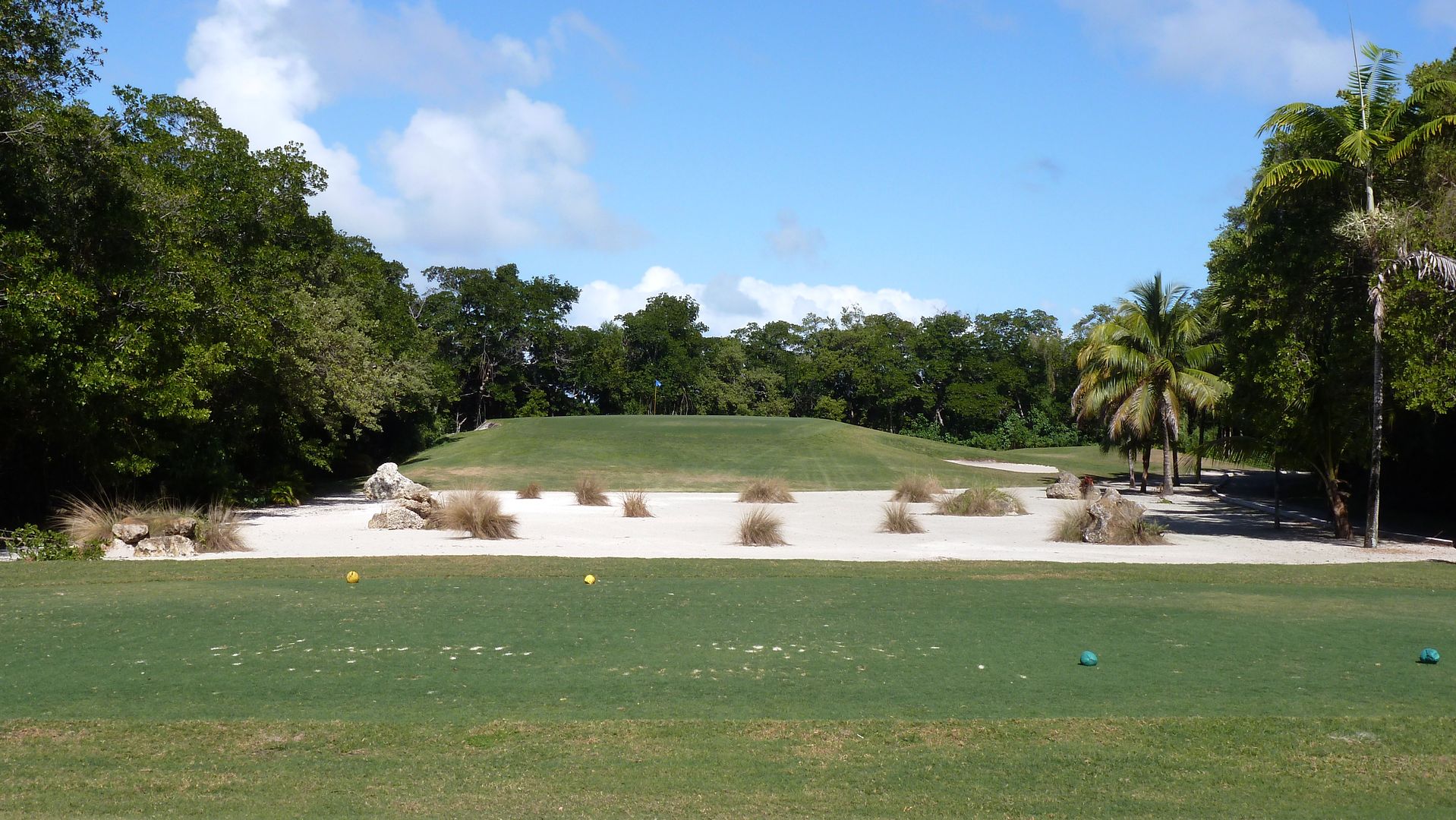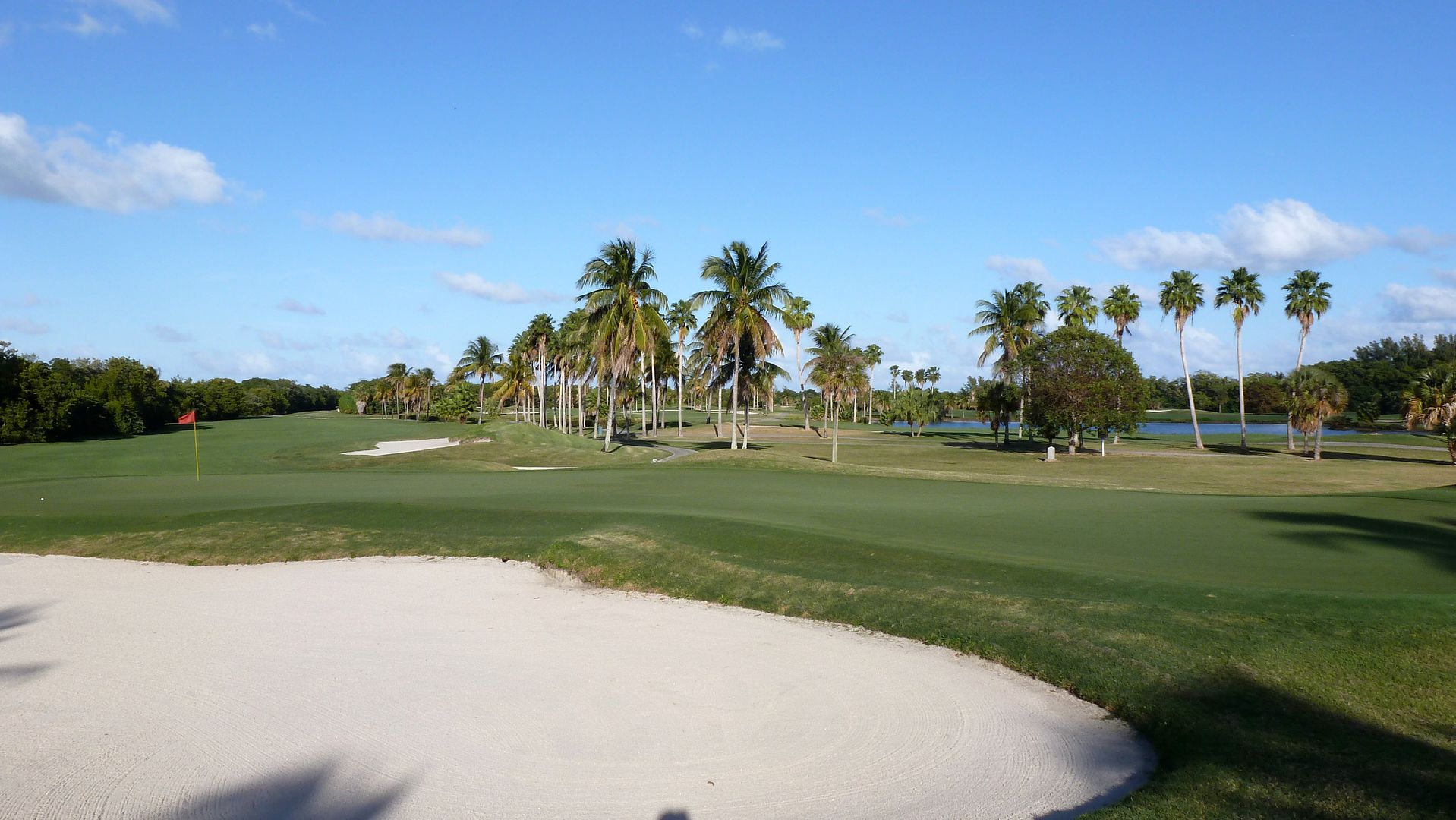 |
| Entrance |
Arcadia Bluffs Golf Club Arcadia, Michigan, USA
Architects: Warren Henderson and Rick Smith (1999)
Yardage: 7,300 Yards, Par 72
Rating/Slope: 75.4/147
My Quick Review: Stop pulling on your beard, grab a beer, hop in a cart and enjoy a golf course with some of the most thrilling shots and most scenic holes in golf.
My ThoughtsEverything about Arcadia Bluffs is massive in scale... The dunes through which the course is routed; the drop-off from the golf course down to Lake Michigan; the bunkering; the greens; the green undulations; the 225-foot elevation from the low-point to the high-point on the course; and most of all, the course is routed over 245(!!) acres.
With 3,100 feet of shoreline, and a forever view of the lake that is nothing less than jaw-dropping, I have heard some claim that Arcadia Bluffs is more beauty than brains. The most common criticisms? (1) An awkward and unwalkable routing; (2) the course feels too man-made; (3) the greens are too wild and undulating. I will do my best to address each criticism.
(1) The RoutingWhen I consider a routing, I ask myself several questions. How does the course interact with natural features? How does the course interact with the wind? How walkable is the golf course? Was the course intended to be walked? Does the course give a sense of intimacy? Does it give a sense of isolation and adventure?
I think the routing at Arcadia Bluffs is exceptional, even if it is a very difficult walk. There are two natural features at Arcadia Bluffs -- the massive dunes and the lake (I include the dunes, even if they are not natural, because they are intended to look and feel natural).
The use of the dunes is genius. Throughout the course of the round, we are treated to shots that are played: through a narrow chute between the dunes giving an intense feeling of isolation (hole 14); over gigantic dunes to a blind fairway that raises the heart-rate and provides a sense of anticipation (hole 10); from the top of the dunes to provide a panorama of the golf course (hole 18); and to a green at the bottom of a dune amphitheatre (hole 6).
The routing also makes excellent use of the lake. Though there is only a single hole on which there is a real risk of losing the ball in the water, Smith/Henderson did a very good job of providing lake vistas on almost every hole. Tees and greens are perched to provide maximum use of the lake. From just about everywhere on the golf course the lake is in view, and there is no way that is an accident. The architects were fortunate to have a piece of land with stunning lake views, and they beat you over the head with them (a good thing!).
Arcadia Bluffs is laid-out on an exceptionally windy site, so how it interacts with the wind (much like courses on windy sites such as Pacific Dunes, Sand Hills and Shinnecock Hills) is vitally important. I have a personal preference for courses that are routed in circles or triangles, rather than courses routed out-and-back (like St. Andrew's (Old)), because of the constant changing interaction with the wind. Arcadia Bluffs' layout is about perfect. The front-nine is comprised of a a seven-hole loop, and two closing holes that provide a unique angle of interaction with the wind. As good as the routing of the front is, the back-nine is better, comprised of an outer-loop and inside-loop (a mini-Muirfield routing). Holes 10-15 make the outer loop, and the three closing holes are shaped in a triangle, guaranteeing three different wind interactions.
Arcadia Bluffs is walkable (I know because I walked it), but it is not easy and is probably best walked only with the help of a caddie, or a playing companion with an empty seat in his cart for the long, uphill walks. But, it must be remembered that the golf course was designed with the cartballer in mind, and this must be respected. The objective of the routing was clearly to make maximum use of the dunes and the lake vistas, with changing wind interaction, and walking as a possibility, but not a priority. In my mind, its goal is perfectly achieved.
One of the great things about walking the golf course, especially a well-routed golf course, is the sense of intimacy it can provide. But, when a golf course is built on 245 acres, with everything on a grand-scale, I am sure intimacy was not a goal of the designers, and honestly I am not sure the sense intimacy is even possible.
(2) The Man-Made FeelingDon't worry, my answer to this one will be shorter. It is my understanding (someone correct me if I am wrong) that the dunes through which the course is routed are man-made. Looking at a picture taken before the golf course was built, it looks that way, though it is difficult to tell for sure:
 |
| Arcadia Bluffs Site - April 22, 1993 |
The features may or may not be man-made, but aside from a bit too much mounding, the dunes feel very natural. I have heard the same criticism of artificiality made of the dunes at Chambers Bay in Washington State. I believe that those that make this claim, at either site, are either (1) much more informed than I, or (2) just looking for fault for fault's sake. Either way, I believe that most people who play the golf course will find the dunes natural feeling and visually appealing.
(3) The Wild GreensThis is the most difficult one for me to answer as I have only seen the golf course twice. I do believe that there is something of a double-standard in place as many of the my favorite courses have very wild greens (i.e. Ballyneal G&HC and The Kingsley Club), yet these criticisms are rarely made. But, the big difference, I think, is that the undulations at those other courses are 'smarter'. That is, many of the undulations have purpose -- they create interesting shot-making possibilities and strategic options. They have significant internal contouring, but perhaps most importantly, that contouring extends to the areas surrounding the greens, creating both a natural feel and multiple ways to play any given shot.
The greens at Arcadia Bluffs, conversely, feel wild just for the sake of being wild. I saw this also at Huntsman Springs (though I would need to see the course a few more times to be sure), where the greens were massive and undulating, but managed to add little interest to the golf course. Furthermore, on most greens at Arcadia Bluffs, the contouring ends at the edge of the green, and from there just flat fairway is found. The greens do not feel as though they were found -- they feel entirely contrived (perhaps this is what the man-made argument is really about??). Furthermore and unfortunately, the greens at Arcadia Bluffs are kept at speeds that do not support the architecture. Resort guests paying over $150 demand fast greens, but I guarantee the golf course would be more fun stimped just a bit (or maybe a lot) slower.
 |
| Clubhouse Sits on the Highest Point on the Golf Course |
Holes to NoteHole 3: Par 5, 502 Yards (Note: all yardages/pictures will be from the 6,702 yard Black Tees)
The golf course starts slowly as the first two holes move away from the lake. While they give an indication of what lies ahead with massive greenside bunkers and wild green undulations, I doubt many golfers will leave Arcadia calling them favorites. The third hole, however, is a stunner.
Teeing off from the top of the dune at the highest point on the golf course, this is a definite photo-op. The entirety of the golf course is laid out in front of you, and the view of the lake seems to go on forever. The tee shot at the 3rd is more intimidating than difficult, provided you are playing the correct set of tees. From the blacks, the carry over the left-side bunkers is under 200 yards, though the ideal tee shot will be played away from the bunkers up the right side of the fairway.
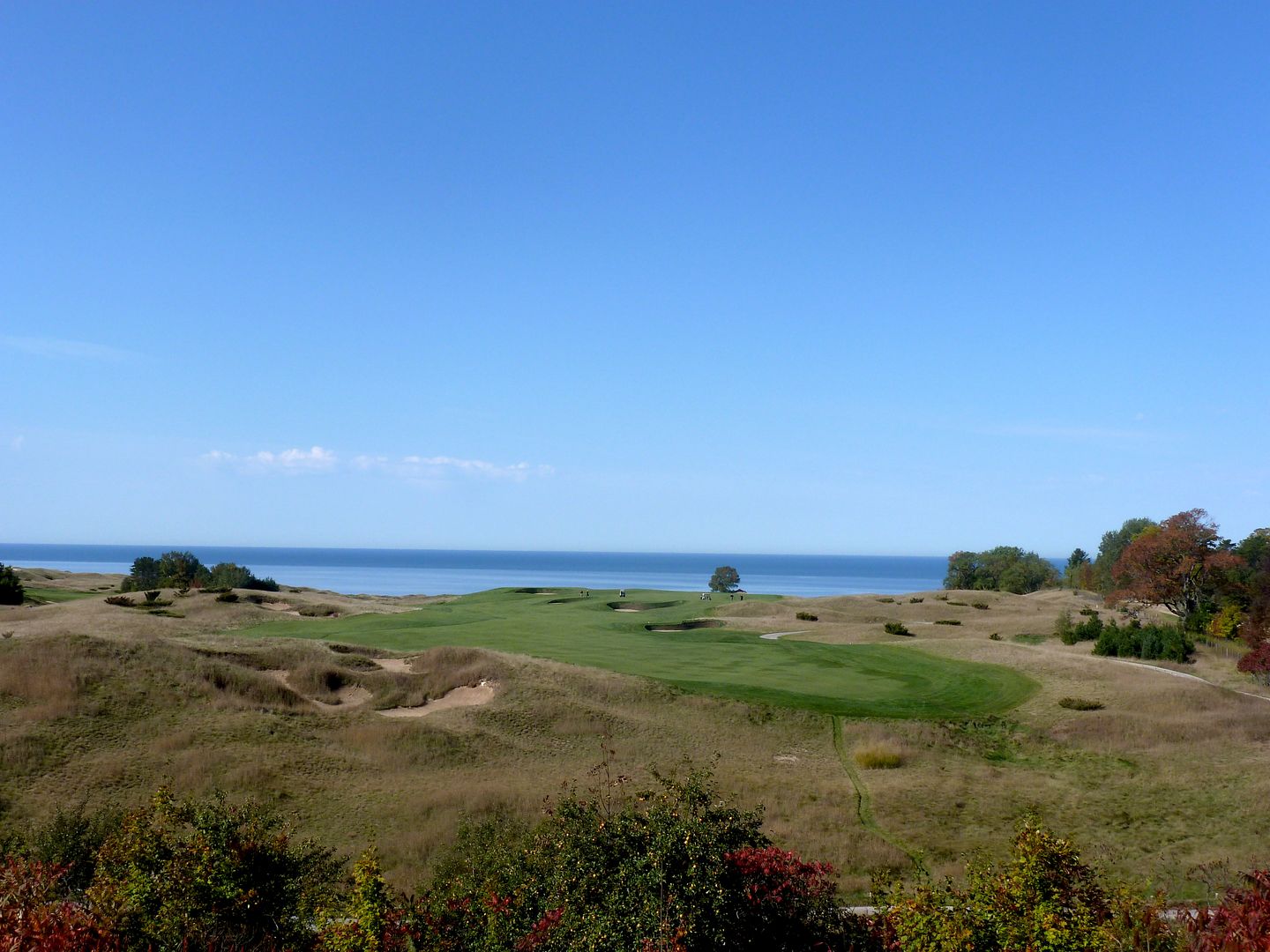 |
| 3rd Tee - Note the walking path |
 |
| 3rd Tee - Zoomed In |
From the fairway on the 3rd, the golfer is confronted with a shot that is similar in principle to the "bottle" template. Play left of the bunkers to the wider portion of the fairway and leave a more difficult approach over a deep bunker to a skyline green at an angle. Play right and over the bunkers and the golfer has a clear look up the throat of the green.
 |
| 3rd - Approach from Left Side of Bottle |
 |
| 3rd - Approach from Right Side of Bottle (Note Scale of Greenside Bunkering) |
From short of the green it is clear the advantage in playing from the right side of the bottle as the green extends a very long way to the left over the greenside bunker. Also note the large undulation in the middle of the green making putts from the front portion to the back portion very difficult.
 |
| 3rd Short of Green |
Hole 5: Par 5, 583 YardsThe 5th is the third hole in a row that plays downhill toward Lake Michigan (the only three-hole stretch routed in the same direction). Despite the length on the scorecard, this hole is very reachable in two if a tee-shot is played down the left side.
 |
| 5th Tee |
From the fairway, the second shot is played over a vast expanse of scrub, humps, and waste bunker. Much like the waste area at the newly renovated Pinehurst #2, your lie in the waste area comes down to luck -- some balls will be easily playable, while others will provide no option but a chip out.
 |
| 5th Fairway |
Most golfers will choose to lay-up to the end of the fairway, leaving a 100 yard pitch into the green. Though the approach should be simple with a wedge to a large green, the carry over the intimidating waste area will cause more than a few chunks and skulls (3/4 in my group).
 |
| 5th Approach |
 |
| A Closer Look at the Scrub Area |
The 5th green is massive and though it is subtle, there is no question the 5th green is a Biarritz green. Also note the hump in the collection area -- I love these kinds of features -- too often pitches from collection areas are easy and straightforward and these humps add all kinds of options.
 |
| 5th Green from Left |
Hole 8: Par 4, 389 YardsIn my mind, the entire interest in the eighth is created by unbelievably deep, right greenside bunker. From the tee, it is impossible not to notice the scale of the greenside bunker, and one's mind immediately begins to calculate the best way to avoid that bunker. Though this is a short hole and the greenside bunker is best avoided by playing from the left, the bunker creates a line of charm over the right fairway bunkers that is hard to ignore.
 |
| 8th Tee |
The approach is uphill to a blind green surface. Once again, the eye is drawn to the massive bunker and no doubt the golfer thinking "anywhere but in that bunker" finds himself too often in that bunker. Of course, the clever play uses the green contours and is played left of the bunker to feed to the right. But, who can ignore the chance to play the Hero Shot over the bunker?
 |
| 8th Approach |
 |
| 8th Greenside Bunker |
Hole 10: Par 4, 424 YardsThe 10th begins one of the most thrilling nines-holes of golf I have ever played. The relative openness of the front-nine ends with the tee shot on the 10th, which is routed narrowly through the massive dunes. The tee shot is blind, played over a barber pole on top of a mound in the distance -- having no idea what lay beyond, there is a wonderful since of anticipation.
 |
| 10th Tee Shot |
The approach to the 10th is played downhill to a green set at the bottom of the dunes -- one of the best and most natural greensites on the course. Tee shots too far left will face a blind approach over the dune on the left in the picture below. The green is best approached from the right.
 |
| 10th Approach from Left Side of Fairway |
 |
| 10th Approach from Centre |
 |
| 10th Greensite |
 |
| 10th Green |
 |
| 10th Green from Left |
Hole 11: Par 5, 594 YardsThis one of those where it helps if you have a playing partner in a cart. The tee shot is played from the top of a dune, a long way and well above the 10th green. The ideal tee shot is played down the left side of the fairway, flirting with the dunes, which should find a speed-slot to propel the tee shot forward. The left side of the fairway is 50 feet above the right side of the fairway and is the preferred side.
 |
| 11th Tee (Gold) |
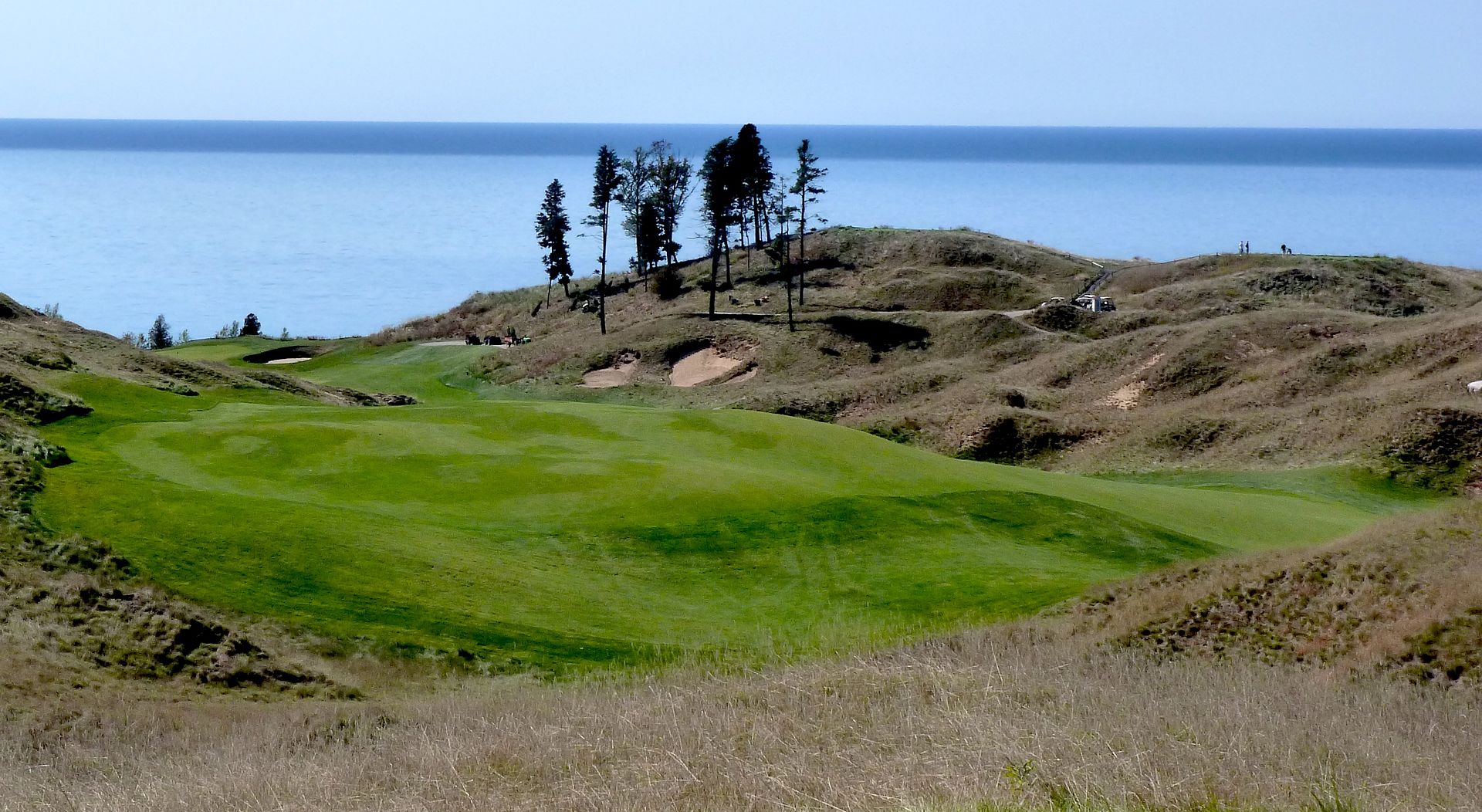 |
| 11th Tee (Black) |
The second shot is played down into a valley between the dunes and a series of bunkers. The fairway in the landing zone is shaped like a bowl, helping marginal shots stay in the fairway. Note the cart in the far-right of the picture below to give a sense in the difference in elevation between the left side of the fairway and the right side.
 |
| 11th Second Shot |
Provided the golfer has found the fairway, the approach to the 11th green should be simple.
 |
| 11th Approach |
If the golfer misses the fairway to the left, the approach to the 11th is anything but simple.
 |
| 11th Approach Left |
A little bunker guards the right side of the green...
Just like the 11th fairway, the 11th green is shaped like a saddle.
 |
| 11th Green |
Hole 12: Par 4, 431 YardsThe only hole on the course that plays along the water's edge. Even though the water should not be in play, it is a factor in the golfer's mind. The ideal line is over the huge waste area on the left, though the fear of sniping one into the lake will have many golfers bailing out to the right.
 |
| 12th Tee |
The approach to the 12th begs for a low-draw, using the contours short of the green to run the ball around the fronting greenside bunkers.
 |
| 12th Approach |
 |
| 12th Greensite - Note Ground Contouring Allowing Shots to Funnel onto Green |
 |
| 12th Green |
 |
| 12th Over Green - Don't Miss Long!! |
Hole 13: Par 3, 210 YardsThis hole may not be a favorite of a GCA enthusiast, but like the rest of the back-nine, it is thrilling. The tee shots requires a carry over a gorge to a green that appears perched atop the cliff.
 |
| 13th Tee |
 |
| 13th Tee (White) |
There is considerably more room to miss short of the green than appears from the tee.
 |
| 13th Short of Green |
The 13th green is one of the least interesting on the course with little contouring and shaped in a large oval.
 |
| 13th Green with 12th Hole in Distance |
Hole 14: Par 4, 340 YardsThe 14th is a very good short par-4. Longer hitters have the option of trying to drive it near the green by carrying the bunkers and dunes on the left. But, a pushed tee shot finds very deep fairway bunkers, from which reaching the green is impossible. Clever players will choose to lay well-back off the tee to the widest part of the fairway. Approaches from the left side of the fairway, near the fairway bunkers, are preferred.
 |
| 14th Tee |
 |
| 14th Tee Zoomed |
The approach from the right side of the fairway must challenge the very deep greenside bunker.
 |
| 14th Approach |
Approaching from the left is much preferred as the bunker need-not be carried, and from this angle it is easier to avoid the large run-off left of the green.
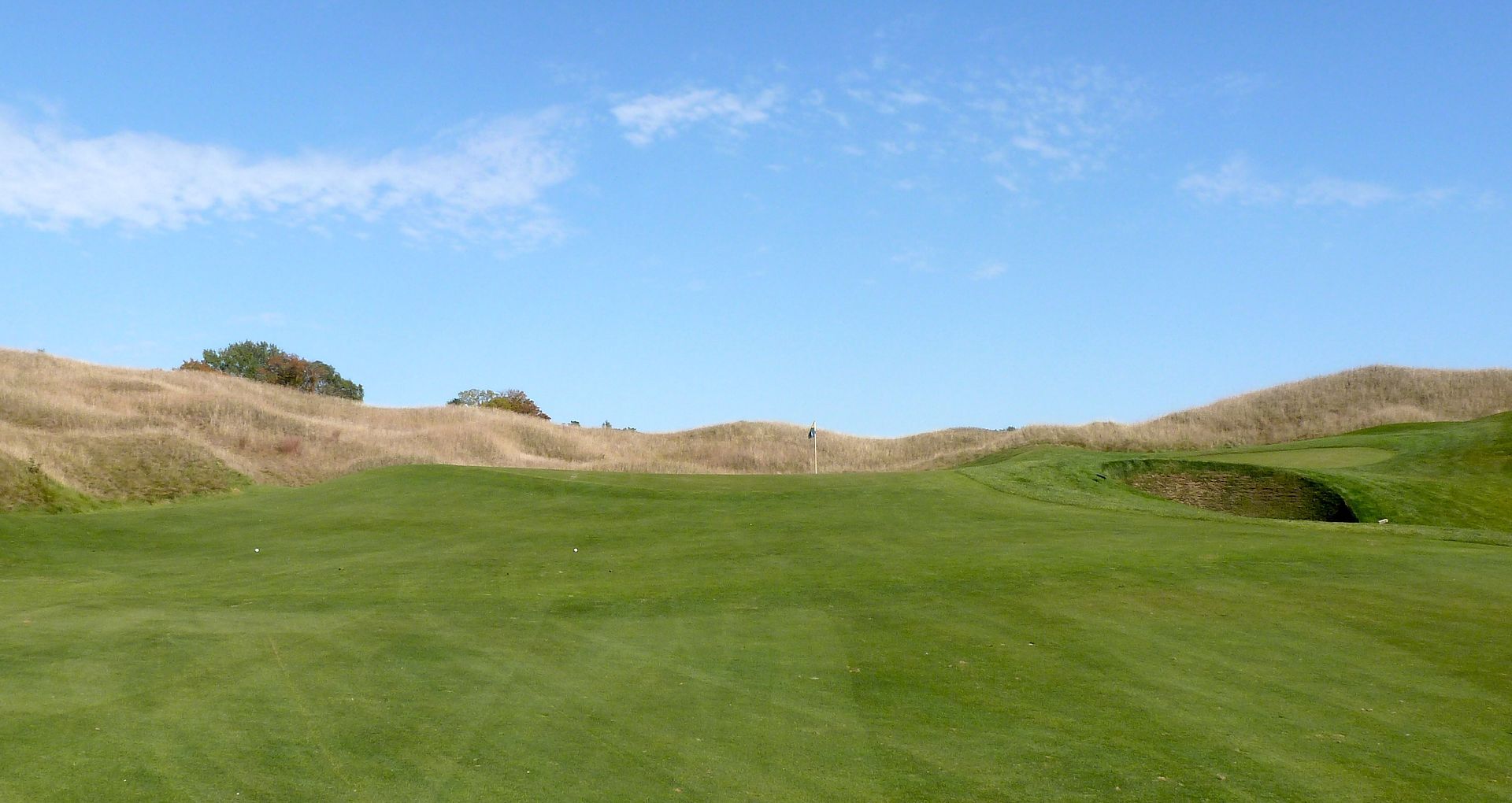 |
| 14th Approach Left |
The single greenside bunker on the 14th may be the deepest greenside bunker I have ever seen. This flat-bottomed pot bunker I believe is deeper than the Road Hole Bunker at St. Andrew's and may even receive the approval of Mr. Melvyn Hunter Morrow.
 |
| 14th Greenside Bunker |
 |
| 14th Green from Behind |
 |
| 14th Greensite from 15 Tee |
Hole 17: Par 3, 167 YardsEasily my favorite par-3 at Arcadia Bluffs. I am unsure of the normal wind direction, but on both days I played Arcadia this hole played hard into and from the left -- I suspect this is the normal wind. What could be a rather unassuming mid-iron par-3 on calm days, is a brute of a par-3 that uphill and into the fan, plays in the 200-yard neighborhood. Like some of the famous greens on classically designed courses, this is a fortress green. Miss left and you find dunes; miss short and you find a deep bunker; miss long or miss right and you find a very deep fall-off.
 |
| 17th Tee |
 |
| 17th Tee Zoomed |
 |
| 17th Forward Tee |
 |
| Fall-off Right of Green |
 |
| Green |











